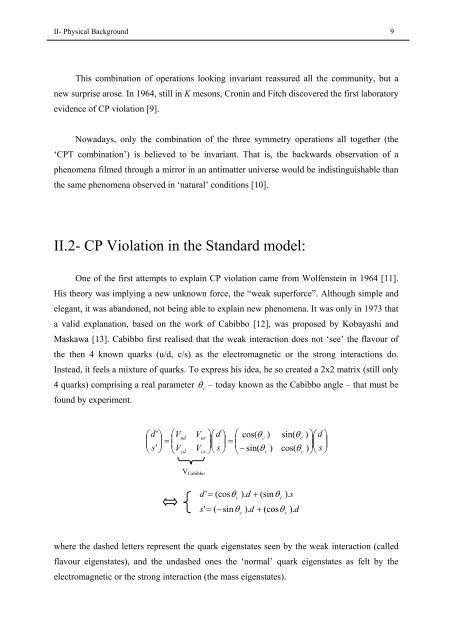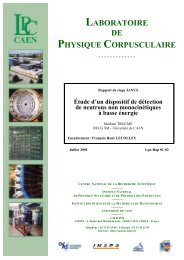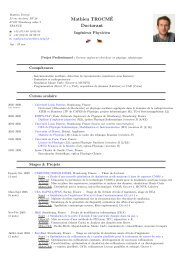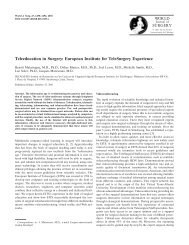Rare B meson decays - mathieu trocmé
Rare B meson decays - mathieu trocmé
Rare B meson decays - mathieu trocmé
You also want an ePaper? Increase the reach of your titles
YUMPU automatically turns print PDFs into web optimized ePapers that Google loves.
II- Physical Background 9<br />
This combination of operations looking invariant reassured all the community, but a<br />
new surprise arose. In 1964, still in K <strong>meson</strong>s, Cronin and Fitch discovered the first laboratory<br />
evidence of CP violation [9].<br />
Nowadays, only the combination of the three symmetry operations all together (the<br />
‘CPT combination’) is believed to be invariant. That is, the backwards observation of a<br />
phenomena filmed through a mirror in an antimatter universe would be indistinguishable than<br />
the same phenomena observed in ‘natural’ conditions [10].<br />
II.2- CP Violation in the Standard model:<br />
One of the first attempts to explain CP violation came from Wolfenstein in 1964 [11].<br />
His theory was implying a new unknown force, the “weak superforce”. Although simple and<br />
elegant, it was abandoned, not being able to explain new phenomena. It was only in 1973 that<br />
a valid explanation, based on the work of Cabibbo [12], was proposed by Kobayashi and<br />
Maskawa [13]. Cabibbo first realised that the weak interaction does not ‘see’ the flavour of<br />
the then 4 known quarks (u/d, c/s) as the electromagnetic or the strong interactions do.<br />
Instead, it feels a mixture of quarks. To express his idea, he so created a 2x2 matrix (still only<br />
4 quarks) comprising a real parameter θ c – today known as the Cabibbo angle – that must be<br />
found by experiment.<br />
⎛d<br />
'⎞<br />
⎛V<br />
⎜ ⎟ = ⎜<br />
⎝ s'<br />
⎠ ⎝V<br />
ud<br />
cd<br />
V<br />
V<br />
us<br />
cs<br />
VCabibbo<br />
⎞⎛d<br />
⎞ ⎛ cos( θ c )<br />
⎟⎜<br />
⎟ = ⎜<br />
⎟ ⎜<br />
⎠⎝<br />
s ⎠ ⎝−<br />
sin( θ c )<br />
d'<br />
= (cosθ<br />
). d + (sinθ<br />
). s<br />
c<br />
s'=<br />
( −sinθ<br />
). d + (cosθ<br />
). d<br />
c<br />
sin( θ ⎞⎛d<br />
c ) ⎞<br />
⎟<br />
⎜ ⎟<br />
cos( θ ⎠⎝<br />
s c ) ⎠<br />
where the dashed letters represent the quark eigenstates seen by the weak interaction (called<br />
flavour eigenstates), and the undashed ones the ‘normal’ quark eigenstates as felt by the<br />
electromagnetic or the strong interaction (the mass eigenstates).<br />
c<br />
c






